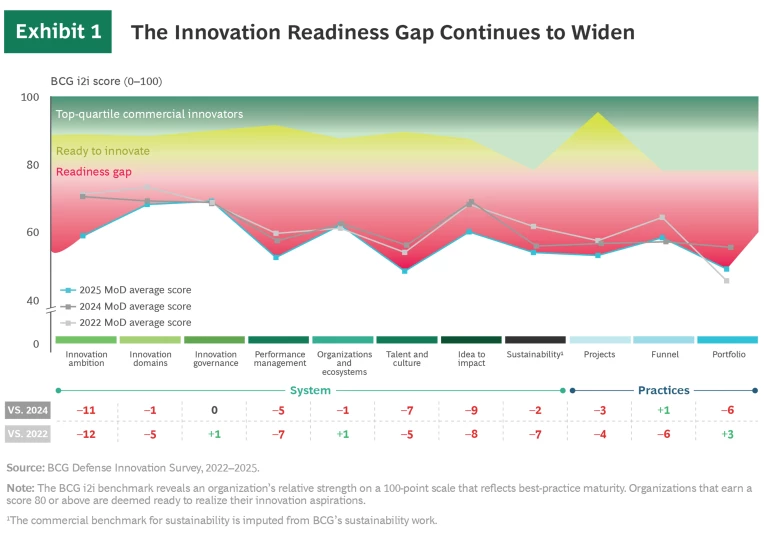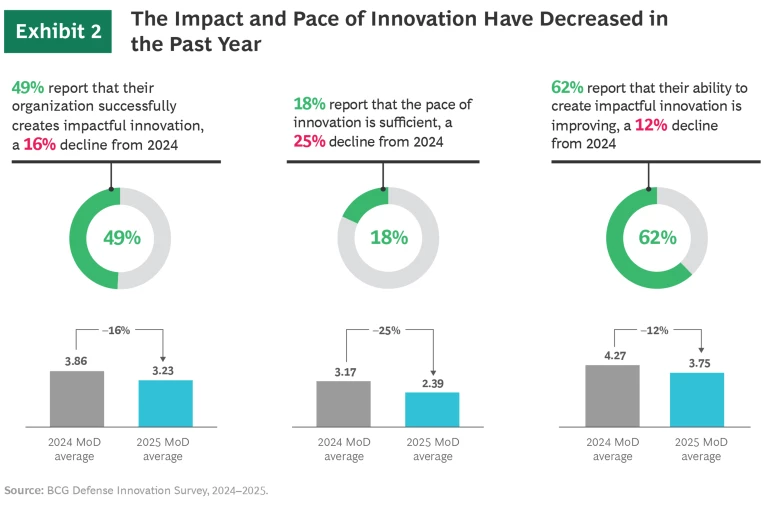Ministries of defense (MoDs) are not meeting their innovation goals. In 2022, the Munich Security Conference Innovation Board (MSC) and Boston Consulting Group (BCG) first identified the defense innovation readiness gap—the gap between ministries’ aspirations for innovation and their ability to generate results. Since then, the gap has widened. External factors such as heightened geopolitical tensions play a role, as do supply chain disruptions and the complexity of emerging technology. Yet many aspects of the forces responsible for expanding the gap lie within MoDs’ control.
As in prior years, we surveyed leaders at 59 ministries of defense, the European Union, and NATO. We benchmarked the results relative to results from the prior three years, as well as to the innovation capabilities of private-sector counterparts, across 11 key dimensions of innovation. We supplemented our quantitative findings with interviews of key public and private national security leaders worldwide.
The results show that the innovation readiness gap continues to widen. On average, MoDs scored 59 against a threshold score of 80—a 5% decline from the 2022 average. Across most innovation dimensions—including ambition, talent and culture, and project management—MoDs’ scores fell below last year’s average and below top-quartile commercial innovators. (See Exhibit 1.) During the same time period, public defense funding increased by up to 12% annually across the G-7 and China.

Our analysis shows that, overall, the innovation capabilities of MoDs surveyed in this report are falling, which may ultimately reduce their field capabilities relative to those of potential adversaries. Respondents clearly note the decline in innovation capabilities. Just 49% of respondents report that their organization successfully creates impactful innovation, 18% report that the pace of innovation is sufficient, and 62% report increased ability to create impactful innovation. These findings represent declines of 16%, 25%, and 12%, respectively, from the previous year’s results, underscoring the need to address the additional barriers to innovation. (See Exhibit 2.)

We analyzed all 11 dimensions of innovation to identify the root causes and key barriers hindering progress. MoDs often point to such known barriers as talent capability gaps, systemic risk aversion, lengthy and rigid acquisition processes, and lack of sufficient funding and partnerships. However, our analysis surfaced a number of other constraints that generally go unspoken or represent new dimensions of the known barriers:
- Missing out on affordability
- Overinvesting in platforms
- Underutilizing AI potential
- Overlooking shifts in the industrial base
- Failing to adopt lessons from current conflicts
- Misunderstanding the known barriers (including talent, risk, acquisition, funding, and partnerships)
These six unspoken barriers prevent MoDs from fully achieving their goals. Often they lie beneath the surface and do not have quick fixes, and experts indicate that most MoDs do not sufficiently discuss them. Although other factors hinder innovation as well, these six were consistent themes in our survey and interviews, and they cut across most of the innovation readiness dimensions.
For that reason, they should be priority targets for MoDs that want to shrink the persistent gap between their innovation readiness intentions and their present innovation capabilities.









